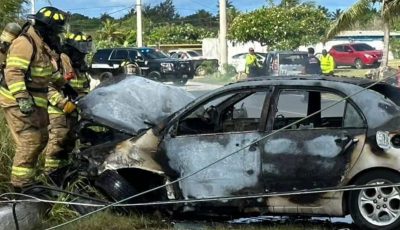Cop’s traffic stop found unlawful; car swerved to avoid puddle, dog
Superior Court Associate Judge Joseph N. Camacho has determined that a police officer failed to establish probable cause to stop a motorist who drove on a lane line for a few seconds after avoiding a dog drinking in a puddle.
In granting Hank Pua Arurang Jr.’s motion to suppress evidence last week, Camacho ruled that there was no probable cause for the traffic stop, since Arurang’s car only momentarily touched the lane line, there was no oncoming traffic or other safety concern, and Arurang did so to avoid a puddle and a dog—in effect avoiding an accident and damage to the vehicle.
Camacho said the traffic stop in this case was unlawful under the Fourth Amendment of the U.S. Constitution and Article I, Section 3 of the Commonwealth Constitution.
Arurang was represented by assistant public defenders Eden Schwartz and Michael Sato. Assistant attorneys general Clayton Graef and Emily Cohen represented the government.
Police officer Daniel Smith, Arurang, and John Leous Jr., a passenger in Arurang’s truck, testified in court during an evidentiary hearing last Nov. 26.
Camacho found all three witnesses to be generally credible. He said there were some discrepancies in their recollection of road conditions that night but overall the witnesses all described the same events.
Concerning the condition of the road, Camacho found the accounts of Arurang and Leous to be more credible than Smith’s account. Camacho noted that there had been rainy weather for several days leading up to the night of the traffic stop.
The judge also noted that Smith himself testified he did not do field sobriety tests because of the condition of the road, and a photograph of the scene of the incident shows a shoulder area where water could pool.
Camacho also noted that Smith’s recollection of the night was not as clear as Arurang’s in other ways, including the number of people in the car and a later conversation.
Smith said his focus was only on the vehicle and that he was not looking for and did not notice a dog or a puddle.
Thus, Camacho said, he finds the account of Arurang and Leous to be more credible concerning the wet road, the existence of a puddle, and the presence of a dog drinking from the puddle.
The case arose from an incident on June 28, 2014, at 4am, when both Arurang and Smith were driving north along Beach Road. Arurang and his two passengers were driving to their barracks near the Marianas Business Plaza.
Arurang was in the inner lane, and Smith was in the outer lane. Arurang passed Smith’s vehicle, signaled and then changed lanes, into the outer lane. Shortly thereafter, Arurang signaled and made a right turn, heading onto the road that goes to the Marianas Business Plaza.
As Arurang made the right turn, he saw a puddle that extended a few feet into the right side of the road and a dog drinking from the puddle.
There was no oncoming traffic, so he moved left and his tires touched the lane line between the eastbound lane and the left turn lane. He heard the sound of the reflectors that designate the lane and moved back into the right lane after passing the puddle and dog.
Smith saw Arurang’s truck driving on the lane line for a few seconds and decided to initiate a traffic stop.
Camacho said unreasonable searches and seizures by the government are prohibited under the Fourth Amendment of the U.S. Constitution and Article 1, Section 3 of the CNMI Constitution.
In this case, Camacho said, the issue is whether driving on a lane line for a few seconds, to avoid a puddle and a dog, violates the Commonwealth Vehicle Code.
The Commonwealth urges the court to take the position that under the Vehicle Code, leaving the boundaries of the right-hand lane is a violation of the law regardless of whether staying in the right-hand lane is practical or safe.
Camacho finds that the evidence presented at the hearing did not establish probable cause that there was a violation of the Traffic Code.
The specific Traffic Code, Camacho said, places a condition on the mandate that a vehicle stay on the right side of the highway, and that a vehicle must stay on the right half so long as the highway is of “sufficient width.”
Here, Camacho said, there was evidence presented that due to the puddle and dog in Arurang’s lane, there was not sufficient space for him to stay in the marked lane.
Camacho said although Arurang did not stay in one lane, he did not violate the Traffic Code because he stayed in his lane “as nearly as practical” and did not move in an unsafe manner.
Camacho said the defendant moved across the lane line only after he had observed a safety concern—the dog drinking from a puddle.
Camacho cited that courts of many other jurisdictions have found that merely momentarily leaving the prescribed lane does not establish probable cause that a traffic violation occurred.
Camacho said considering the specific facts of this case—where in the absence of oncoming traffic, Arurang moved out of his lane to avoid hitting and driving through a puddle—there was no probable cause to initiate a traffic stop.


























